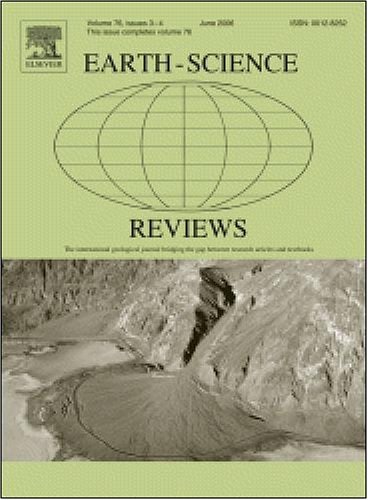Multi-episode metamorphism and magmatism in the Paleozoic Altyn Orogen, West China: Implications for the tectonic evolution of the Proto-Tethys Ocean
IF 10.8
1区 地球科学
Q1 GEOSCIENCES, MULTIDISCIPLINARY
引用次数: 0
Abstract
The Proto-Tethys Ocean plays a significant role in the processes of supercontinent breakup-assembling and Eurasia's formation history. The Paleozoic Altyn Orogen marks the northern boundary of the Proto-Tethys Ocean realm and holds the deepest records of continental subduction, but the detailed tectonic evolution of this orogen remains controversial. We present a systematic overview of recent studies of metamorphism and granitoid magmatism within the Paleozoic Altyn Orogen. This Orogen includes the North Altyn Tectonic Belt (NAB), Central Altyn Block (CAB) and South Altyn Tectonic Domain (SAD), in which four-episode metamorphism (M-I to -IV) and five-episode granitoid magmatism (G1–5) are recognized. The M-I metamorphism is marked by high-pressure and low-temperature (HP-LT) eclogites with ages of >522 Ma in the NAB, which, together with the arc-related G1 granitoids of 536–510 Ma, indicates an early Cambrian cold subduction. The M-II metamorphism is characterized by ultrahigh-pressure (UHP) rocks in the SAD. It shares clockwise P–T paths characterized by the prograde to the Pmax (peak pressure) (M-IIa) stage at ∼500 Ma and post-Pmax decompression to high amphibolite facies or HP-(U)HT (ultrahigh- to high-temperature) granulite facies conditions (M-IIb) at ∼480 Ma. The Pmax conditions of M-IIa vary from the stability field of quartz to that of coesite and stishovite, registering continental subduction to different mantle depths with the maximum up to 300 km. The M-IIa metamorphism was accompanied by the G2 adakitic granitoids with ages of 510–500 Ma, and M-IIb metamorphism was associated with the G2 A-type granitoids aged 495–480 Ma, related to the subduction and exhumation of a microcontinent. The M-III metamorphism is represented by LP-(U)HT granulites with ages of 462–441 Ma and LP overprinting on the exhumed HP-UHP rocks in the SAD. This LP metamorphism, associated with the G3 I/A-type granitoids (475–450 Ma), may indicate an arc/backarc extension. The M-IV metamorphism occurred in the SAD involves an earlier HP eclogite stage at ∼430 Ma (M-IVa) and a later granulite facies overprinting stage at ∼400 Ma (M-IVb). The M-IVa, together with the G4 adakitic granitoids (450–420 Ma), suggests closing of the backarc basins with crustal thickening. While the M-IVb, along with the G5 A-type granitoids (420–370 Ma), indicates the post-collision extension. Summarizing the regional metamorphism, granitoid magmatism and other geological data, we propose an alternative model to address tectonic evolution of the Altyn Orogen. It involves: (i) the early subduction of the Proto-Tethys Ocean (>522–510 Ma), (ii) subsequent micro-continental subduction and exhumation (510–480 Ma), (iii) late oceanic subduction and arc-backarc extension (475–450 Ma), (iv) closing of the backarc basin and continental subduction-collision (450–420 Ma) in response to the final closure of the Proto-Tethys Ocean, and (v) post-collisional extension (<420 Ma). This model indicates that the tectonic evolution of the Proto-Tethys realm includes two cycles from oceanic subduction to continental subduction-collision with two episodes of UHP metamorphism, intervened by a phase of arc/backarc extension with LP metamorphism. The similar tectonic scenarios may have also occurred in the North Qinling region in the east Proto-Tethys realm, but have not been reported from other UHP terranes worldwide.
中国西部阿尔金造山带古生代多期变质与岩浆作用:对原特提斯洋构造演化的启示
原特提斯洋在超大陆的分裂组装过程和欧亚大陆的形成历史中起着重要的作用。古生代阿尔金造山带标志着原特提斯洋领域的北部边界,拥有大陆俯冲的最深记录,但该造山带的详细构造演化仍然存在争议。本文对古生代阿尔金造山带内变质作用和花岗岩类岩浆作用的最新研究进行了系统的综述。该造山带包括北阿尔金构造带(NAB)、中阿尔金地块(CAB)和南阿尔金构造域(SAD),其中存在4期变质作用(M-I ~ -IV)和5期花岗岩浆作用(G1-5)。NAB的M-I变质作用以522 Ma的高压低温榴辉岩(HP-LT)为标志,与536 ~ 510 Ma的G1型花岗岩相结合,表明早寒武世的冷俯冲作用。塔里木盆地M-II变质作用以超高压(UHP)岩石为主。它具有顺时针的P-T路径,其特征是在~ 500 Ma时进入Pmax(峰值压力)(M-IIa)阶段,在~ 480 Ma时,Pmax后减压到高角闪岩相或HP-(U)HT(超高至高温)麻粒岩相条件(M-IIb)。M-IIa的Pmax条件从石英稳定场到硅长石和辉长石稳定场各不相同,表明大陆俯冲到不同的地幔深度,最大可达300 km。M-IIa型变质作用与G2型阿达奇花岗岩相结合,花岗岩的年龄为510 ~ 500 Ma; M-IIb型变质作用与G2 a型花岗岩相结合,花岗岩的年龄为495 ~ 480 Ma,与微大陆的俯冲和发掘有关。M-III变质作用以LP-(U)HT麻粒岩为代表,年龄为462 ~ 441 Ma, LP套印在南缘发掘的HP-UHP岩石上。与G3型I/ a型花岗岩类(475 ~ 450 Ma)有关的近程变质作用可能表明弧后伸展作用。在SAD发生的M-IV变质作用包括较早的~ 430 Ma (M-IVa)的HP榴辉岩阶段和较晚的~ 400 Ma (M-IVb)的麻粒岩相叠印阶段。M-IVa与G4艾达质花岗岩类(450 ~ 420 Ma)表明弧后盆地闭合,地壳增厚。而M-IVb与G5 a型花岗岩类(420 ~ 370 Ma)显示碰撞后伸展。总结区域变质作用、花岗岩浆作用等地质资料,提出了阿尔金造山带构造演化的替代模型。它涉及:(i)原特提斯洋的早期俯冲(522-510 Ma), (ii)随后的微大陆俯冲和出露(510-480 Ma), (iii)晚期海洋俯冲和弧后伸展(475-450 Ma), (iv)弧后盆地闭合和大陆俯冲碰撞(450-420 Ma),以响应原特提斯洋的最终闭合,(v)碰撞后伸展(<420 Ma)。该模型表明,原特提斯领域的构造演化包括两个旋回,从大洋俯冲到大陆俯冲碰撞,其中有两期超高压变质作用,其间有一个弧后伸展期和低压变质作用。类似的构造情景也可能发生在原特提斯域东部的北秦岭地区,但在世界范围内的其他超高压地质体中尚未报道。
本文章由计算机程序翻译,如有差异,请以英文原文为准。
求助全文
约1分钟内获得全文
求助全文
来源期刊

Earth-Science Reviews
地学-地球科学综合
CiteScore
21.70
自引率
5.80%
发文量
294
审稿时长
15.1 weeks
期刊介绍:
Covering a much wider field than the usual specialist journals, Earth Science Reviews publishes review articles dealing with all aspects of Earth Sciences, and is an important vehicle for allowing readers to see their particular interest related to the Earth Sciences as a whole.
 求助内容:
求助内容: 应助结果提醒方式:
应助结果提醒方式:


